52 Wildlife Weekends
A year of British wildlife-watching breaks
By James Lowen, published by Bradt Travel Guides, ISBN-13: 978 1 84162-464 8
Have you ever found yourself at a loss for something to do at the weekend? You’ve got two whole days away from the office to enjoy the great outdoors but you can’t decide where to spend it. Where’s the best area to visit in March if you want to see a ‘wailing heath chicken’? Or what could you do over the weekend in November if you’re footloose and fancy-free and feel like a bit of wildlife-watching? This latest edition to the marvellous stable of Bradt Travel Guides could be the answer to your problem.
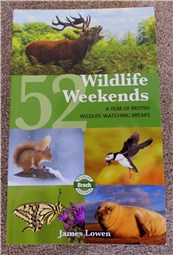
52 Wildlife Weekends: off to a great start with this eye-catching cover
As its name suggests,
52 Wildlife Weekends offers you an exciting, wildlife-packed suggestion for every single weekend of the year, from the first weekend in January right through every season until the end of December. Whether your interest lies in searching for delicate wild flowers, seeking out elusive mammals, catching up with the best bird spectacles or chasing daytime moths, this book has it covered. The book even starts with a helpful guide to help you make the most of the information provided and to help you plan the perfect wildlife-watching weekend.
The simplest way to plan your trip is to look at the Contents section at the beginning of the book. For each month, the author James Lowen suggests either four or five weekend sorties to different locations across the country for the very best wildlife experience at that time of year to give you 52 exciting weekend itineraries. So January for example starts with a wild goose chase on the Scottish islands but also includes looking for wild swans in Cambridgeshire, deer in Hampshire, seals in Cleveland and seaduck and eagles in Fife.
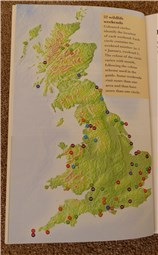
Map gives you an overview of the national distribution of James' top wildlife destinations
Each weekend outline includes a descriptive and evocative write-up of the specific locations you should visit within the selected area and what wildlife to look for during your visit, as well as snippets of fascinating wildlife-related information, For example, did you know that Barnacle Geese gained their name not because they like to eat crustaceans but because it was long thought that they grew underwater in barnacle shells before emerging above the waves in autumn. That’s got to be worth a point or two in a pub quiz! After whetting your appetite for the wildlife delights you can experience, each weekend section then covers the practicalities of exactly where to go and where to stay. Addresses, websites, telephone numbers are all listed to help you make your arrangements. And if you can’t make your visit at the weekend scheduled, the ‘Flexibility’ section suggests alternative times of year to visit.
And if you want to plan your weekends around particular species, 52 Wildlife Weekends has got that covered too. Simply look up your chosen wildlife spectacle and the book lists which weekends you should refer to for the best viewing opportunities.
All this great information is packaged in a handy-sized and beautifully illustrated book. The sumptuous photographs on the front cover provide a taster of the wonderful variety of wildlife that can be enjoyed across Britain. They set the tone for the chapters within which are all lavishly illustrated with wonderful close-up colour photographs of the key target species. If you don’t manage to get out into the countryside over the weekend, an armchair tour with this book is the next best thing. A book that packs in so much information and looks so good is not just a useful guide, it’s a great addition to any bookshelf.
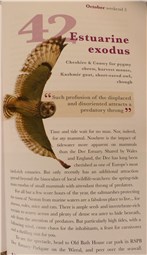
Estuarine Exodus - where to go wildlife-watching on our local patch
Of course, we couldn’t resist checking out James’ recommendations for an area we know like the back of our hand, the North Wales coast. Our ‘local patch’ is included in an October weekend trip entitled ‘Estuarine Exodus’. Day one is spent on the Dee estuary, one of our favourite local areas for the spectacle of birds en mass. James suggests timing your visit for the particular high tides and heading for Parkgate and we’d wholeheartedly endorse his suggestion. The sight of so many waders and wildfowl being pushed off their usual roosting sites by the encroaching tide is uplifting to the soul as the birds wheel and swirl making ever-changing shapes in the air like a kaleidoscope. As the waters creep remorselessly higher and higher, the land mammals also find themselves fleeing to safety ahead of the water, and you may find that your boot inadvertently provides a safe haven for an escaping shrew or bank vole desperately seeking the highest point above the tide. Danger doesn’t just lurk in the water either, as opportunist raptors gather to take advantage of this unexpected meal being rustled up for them. Close encounters with hunting Marsh Harrier, Short-eared Owl, even Peregrine or Merlin are a bonus from the secure perspective of a human, if not perhaps from the point of view of a small mammal. Visiting this area at any high tide can be rewarding, but as James rightly says, at the high spring-tides it is truly ‘exhilarating’.
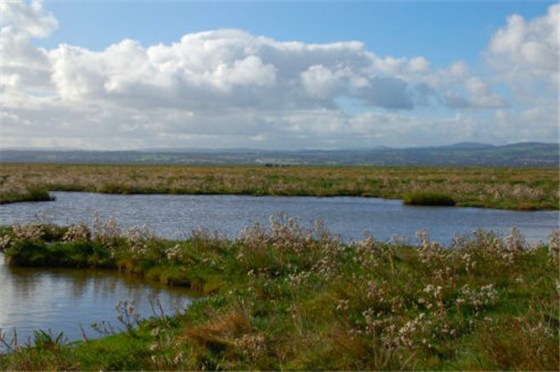
Parkgate Marsh before a spring-tide
His suggestion for your second day in the area is to visit the Great Orme, which we fondly call our ‘back garden’. Again James’ description in the book is spot-on, as he writes about the wonderful landscape of this towering limestone peninsula and suggests where and at what time of year you are likely to encounter the best wildlife. It’s a good place to see Chough, a ‘ragamuffin of a crow’ as James describes it; while its feathers may perhaps look a little unkempt, its matching red legs and decurved bill are particularly smart. Constantly on the move on the ground as it probes the soil for larvae, this is a bird with total mastery of the air currents; it’s a rare bird on a national basis so we’re fortunate to have such a flying ace up our sleeves here on the Great Orme. James also suggests the best corners of the peninsula to catch up with migrant birds pausing on their long journey to their wintering grounds.
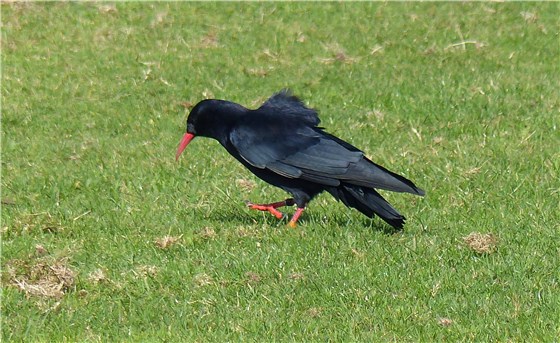
Charismatic Chough, always on the go
If mammals are more your thing, autumn’s a particularly good time to enjoy the wonderful feral Kashmir goats that inhabit the Great Orme. October is their rutting season so while you may see plenty of male goat action, staying upwind would be a good tip to ensure you enjoy the experience: a pumped-up testosterone-loaded male Kashmir has an odour only an amorous female could find attractive!
As the perfect antidote to all that hormonal activity, James recommends rounding off your day at RSPB Conwy, an ideal location to enjoy a wide variety of birds on the lagoons and the River Conwy estuary before refreshing yourself after all that wildlife-watching with a cuppa in the Waterside Coffee Shop.
After you’ve read all about it, the chapter concludes with a summary of all the information you could possibly need to arrange your own wildlife-watching weekend on the North Wales coast with grid references, web addresses and telephone numbers for the reserves and possible places to stay. It also includes contact details for expert local guides, in this case ourselves at The Biggest Twitch (
info@thebiggesttwitch.com) – well, who better to guide you around the delights of North Wales!
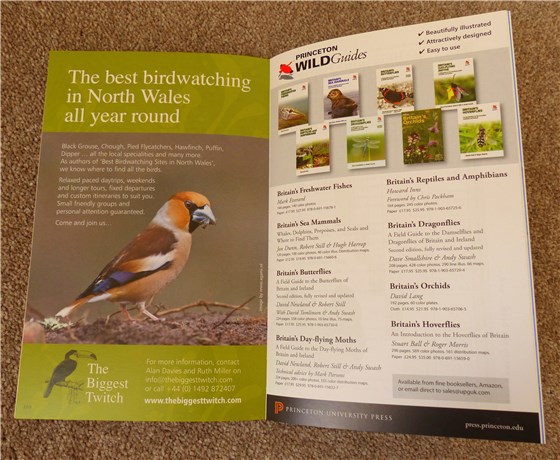
The range of Princeton WildGuides, plus a Biggest Twitch Hawfinch!
In our view, the author has done a cracking job of directing you on where to experience the best wildlife-watching in our local area, so we know that the he will have been equally rigorous and accurate right across the country.
All in all, 52 Wildlife Weekends is not only lovely to thumb through in the comfort of your armchair, it’s also practical to use and is the perfect guide to help you plan a weekend in the country enjoying the very best wildlife that Britain has to offer.
So what are you waiting for? Go on, grab a copy and get out there. Enjoy your wildlife!
Review by Ruth Miller and Alan Davies
The Biggest Twitch
November 2013
If you have a wildlife-related book that you would like us to review, please contact us on
info@thebiggesttwitch.com.